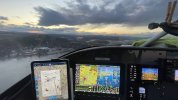mikelupo
Member
Do LNAV+V approach advisory altitudes only apply at the fixes?
Granted the LNAV+V should really be treated as a lateral guidance only with vertical "advisory", but the AP when coupled, with VNAV, should not descend below the advisory altitudes as depicted on the approach chart (according to what I recall about the 430W).
Since my new HDX install I have test flown (twice) the same RNAV approach (LNAV+V) at KLCI Runway 26 in VFR weather. Both times, the autopilot flew lower than my previously installed TruTrak system.
If you look at the attached photo, the PAPIs are all red. Even at ZUROT they were red.
Before the HDX retrofit, I had a TruTrak EFIS (integrated auto pilot) and was slaved to my 430 WAAS.
I have the same navigator, yet all new Autopilot (Dynon HDX, Dual ADAHRS, ARINC249, etc).
The AP on that did not go lower than the prescribed altitudes. I always saw two red/two white.
After the first time, I surmized that I must have set the altimeter incorrectly. So the second time (days later) I did it again and double checked my altimeter setting.
What I didn't do was verify my altitudes at ZUROT(2900+) or REZDI (2200+) or greater. So that's still a data point I will gather on my next attempt.
I will also try a different RNAV. I'll try an LPV next. Runway 8 at KLCI also has that, do I don't have to venture far.
In case anyone asks, yes, I flew an ILS approach and that was spot on.
Shared experiences are welcome!
Some facts:
430 was in VLOC mode and was indicating LNAV+V.
The 430, not being in GPS mode, was a procedural error.
I'm still learning and hence, why doing this in VFR with a safety is really important.
I had flown for 45-ish minutes at a few different altitudes. So I don't think there was any error that had to be calculated by the HDX. (reading the VNAV section of the user guide). I also do not believe the servo is slipping.
Dynon AP was coupled in VNAV mode.
The Dynon Altimeter agrees with the G5.
Pitot/Static certification was done in Sept, 2024. Technician said that the leakdown test was among the best he's encountered. that said, I have no reason to believe the static system here is at play.
I can confirm that the alt static source is switched off.
Granted the LNAV+V should really be treated as a lateral guidance only with vertical "advisory", but the AP when coupled, with VNAV, should not descend below the advisory altitudes as depicted on the approach chart (according to what I recall about the 430W).
Since my new HDX install I have test flown (twice) the same RNAV approach (LNAV+V) at KLCI Runway 26 in VFR weather. Both times, the autopilot flew lower than my previously installed TruTrak system.
If you look at the attached photo, the PAPIs are all red. Even at ZUROT they were red.
Before the HDX retrofit, I had a TruTrak EFIS (integrated auto pilot) and was slaved to my 430 WAAS.
I have the same navigator, yet all new Autopilot (Dynon HDX, Dual ADAHRS, ARINC249, etc).
The AP on that did not go lower than the prescribed altitudes. I always saw two red/two white.
After the first time, I surmized that I must have set the altimeter incorrectly. So the second time (days later) I did it again and double checked my altimeter setting.
What I didn't do was verify my altitudes at ZUROT(2900+) or REZDI (2200+) or greater. So that's still a data point I will gather on my next attempt.
I will also try a different RNAV. I'll try an LPV next. Runway 8 at KLCI also has that, do I don't have to venture far.
In case anyone asks, yes, I flew an ILS approach and that was spot on.
Shared experiences are welcome!
Some facts:
430 was in VLOC mode and was indicating LNAV+V.
The 430, not being in GPS mode, was a procedural error.
I'm still learning and hence, why doing this in VFR with a safety is really important.
I had flown for 45-ish minutes at a few different altitudes. So I don't think there was any error that had to be calculated by the HDX. (reading the VNAV section of the user guide). I also do not believe the servo is slipping.
Dynon AP was coupled in VNAV mode.
The Dynon Altimeter agrees with the G5.
Pitot/Static certification was done in Sept, 2024. Technician said that the leakdown test was among the best he's encountered. that said, I have no reason to believe the static system here is at play.
I can confirm that the alt static source is switched off.

